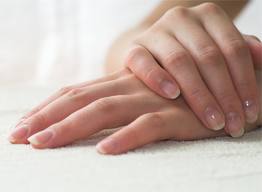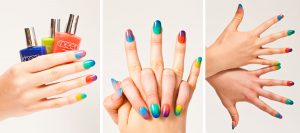Your toenails and fingernails protect the tissues of your toes and fingers. They are made up of layers of a hardened protein called keratin, which is also in your hair and skin. The health of your nails can be a clue to your overall health. Healthy nails are usually smooth and consistent in color. Specific types of nail discoloration and changes in growth rate can be signs of lung, heart, kidney, and liver diseases, as well as diabetes and anemia. White spots and vertical ridges are harmless.


Nail problems that sometimes require treatment include
- Bacterial and fungal infections
- Ingrown nails
- Tumors
- Warts
Keeping your nails clean, dry, and trimmed can help you avoid some problems. Do not remove the cuticle, which can cause infection.
Cuticles are important
Though you may only think about your cuticles when you get a manicure, they’re not just hanging out on your hands. They serve a purpose, and they need your TLC.
Your cuticles are part of your skin.They sit atop your nails’ growth matrix, which is the part of your nails that grows.
Cuticles are “there for a reason, like a barrier or a protection for the nail matrix,” says Richard Scher, MD, a Cornell University dermatology professor.
How to take care of cuticles and nails
To keep that protection as a barrier strong, follow these six tips.
1. Don’t Cut Your Cuticles.
Dermatologists say there’s no good reason to cut the cuticles.
Cutting them could open the door to infection or irritation. “If you remove the cuticle, that space is wide open, and anything can get in there,” Scher says.
Cutting your cuticles can also lead to nail problems, such as ridges, white spots, or white lines.
If you get bacterial infection in that area, it can hamper that fingernail’s growth.”That’s not particularly aesthetic, as well as being uncomfortable,” says Ella Toombs, MD, a Washington, D.C., dermatologist.
2. Go Orange.
If you’re hoping to make your nails appear longer, you can push your cuticles back gently with a wooden orange stick instead.
“Cuticles don’t want to be cut,” Toombs says. “They’re supposed to be soft, and cutting can make them hard, more likely to fracture. If you cut it, it has an increased tendency to split off.”
3. Moisturize.
Although the cuticles don’t feel like the soft skin on the rest of your hands, they’re composed primarily of skin, so it’s essential to keep them moisturized.
“Cuticles get dry. They crack, peel, and flake, just like the skin does,” Scher says. “A good moisturizer for the cuticles is important, just like for dry skin. Any skin moisturizer will work fine for the cuticles. When you put it on your hands and there’s some left over, rub it into the cuticles.”
3. Moisturize. continued…
You can use ointments at night when you aren’t touching papers in your office. Lotions can be used throughout the day, because the hands don’t get as greasy, but lotions aren’t as moisturizing as creams and ointments.”
A hot wax treatment, which may be offered at the nail salon, is another good way to moisturize the cuticles.
People dip their hands into the warm, oily wax, then put on plastic gloves and a mitt to seal in the heat, which they wear for 10 to 15 minutes.
After you take it off, the hands, nails, and cuticles are softer. It’s a wonderful treatment for nails and cuticles.”
Whatever method you choose, be sure to moisten your hands regularly.
The more frequently you lubricate the hands, including the nails and cuticles, the better they will be.
4. Avoid Rough Manicurists.
Many people see their dermatologist when they develop red, sore spots around their nails or cuticles caused by a skin infection called paronychia.
Before getting your nails done, tell your manicurist that you only want your cuticles pushed back very gently with an orange stick, nothing more. If she pushes the cuticles too vigorously, ask her to stop right away.
5. Steer Clear of Drying Agents.
The hands, nails, and cuticles can dry out from frequent dish washing and from nail polish remover containing acetone. So, experts recommend wearing gloves for dish duty and using acetone-free nail polish remover.
Whether washing clothes or dishes, you really need to wear vinyl gloves. That’s a good time to put the lubricant on. Having the gloves on keeps the oil on the cuticle and nail plate, and it protects them from the drying effects of water.
6. Keep Your Hands Out of Your Mouth.
“Your mouth is a dirty area, and saliva is an enzyme that breaks down skin,” Robinson says. “You can get an infection if you violate the cuticle.”
So if you have a habit of biting your nails or nibbling on your cuticles, work on kicking those habits for prettier, healthier hands.